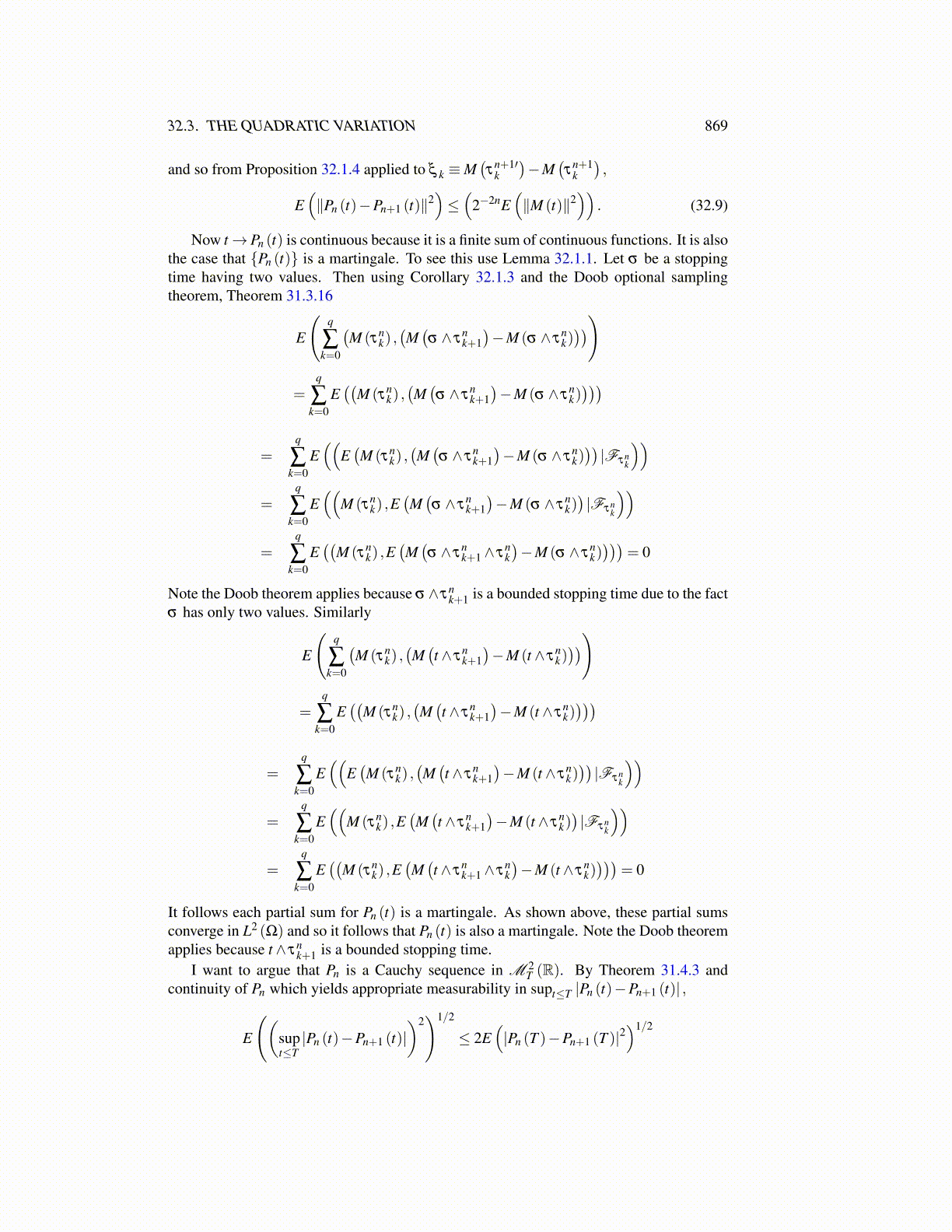
32.3. THE QUADRATIC VARIATION 869
and so from Proposition 32.1.4 applied to ξ k ≡M(τ
n+1′k
)−M
(τ
n+1k
),
E(∥Pn (t)−Pn+1 (t)∥2
)≤(
2−2nE(∥M (t)∥2
)). (32.9)
Now t→ Pn (t) is continuous because it is a finite sum of continuous functions. It is alsothe case that {Pn (t)} is a martingale. To see this use Lemma 32.1.1. Let σ be a stoppingtime having two values. Then using Corollary 32.1.3 and the Doob optional samplingtheorem, Theorem 31.3.16
E
(q
∑k=0
(M (τn
k) ,(M(σ ∧ τ
nk+1)−M (σ ∧ τ
nk))))
=q
∑k=0
E((
M (τnk) ,(M(σ ∧ τ
nk+1)−M (σ ∧ τ
nk))))
=q
∑k=0
E((
E(M (τn
k) ,(M(σ ∧ τ
nk+1)−M (σ ∧ τ
nk)))|Fτn
k
))=
q
∑k=0
E((
M (τnk) ,E
(M(σ ∧ τ
nk+1)−M (σ ∧ τ
nk))|Fτn
k
))=
q
∑k=0
E((
M (τnk) ,E
(M(σ ∧ τ
nk+1∧ τ
nk)−M (σ ∧ τ
nk))))
= 0
Note the Doob theorem applies because σ ∧τnk+1 is a bounded stopping time due to the fact
σ has only two values. Similarly
E
(q
∑k=0
(M (τn
k) ,(M(t ∧ τ
nk+1)−M (t ∧ τ
nk))))
=q
∑k=0
E((
M (τnk) ,(M(t ∧ τ
nk+1)−M (t ∧ τ
nk))))
=q
∑k=0
E((
E(M (τn
k) ,(M(t ∧ τ
nk+1)−M (t ∧ τ
nk)))|Fτn
k
))=
q
∑k=0
E((
M (τnk) ,E
(M(t ∧ τ
nk+1)−M (t ∧ τ
nk))|Fτn
k
))=
q
∑k=0
E((
M (τnk) ,E
(M(t ∧ τ
nk+1∧ τ
nk)−M (t ∧ τ
nk))))
= 0
It follows each partial sum for Pn (t) is a martingale. As shown above, these partial sumsconverge in L2 (Ω) and so it follows that Pn (t) is also a martingale. Note the Doob theoremapplies because t ∧ τn
k+1 is a bounded stopping time.I want to argue that Pn is a Cauchy sequence in M 2
T (R). By Theorem 31.4.3 andcontinuity of Pn which yields appropriate measurability in supt≤T |Pn (t)−Pn+1 (t)| ,
E
((supt≤T|Pn (t)−Pn+1 (t)|
)2)1/2
≤ 2E(|Pn (T )−Pn+1 (T )|2
)1/2